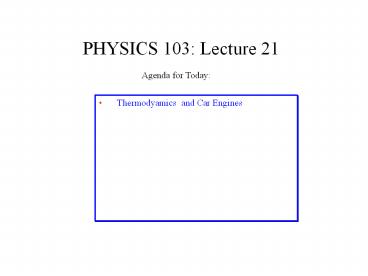PHYSICS 103: Lecture 21 - PowerPoint PPT Presentation
Title:
PHYSICS 103: Lecture 21
Description:
Heat flows from hot objects to cold objects until they have the same temperature. ... Why is a car more likely to knock on a hot day than a cold day? ... – PowerPoint PPT presentation
Number of Views:93
Avg rating:3.0/5.0
Title: PHYSICS 103: Lecture 21
1
PHYSICS 103 Lecture 21
Agenda for Today
- Thermodyamics and Car Engines
2
LAWS OF THERMODYNAMICS ZEROTH LAW
Heat flows from hot objects to cold objects until
they have the same temperature.
3
LAWS OF THERMODYNAMICS FIRST LAW
Conservation of Energy
All energy entering a system must be conserved
HEAT Q
I N
Change in internal energy
DU
WORK W F?d
OUT
Q DU W
4
LAWS OF THERMODYNAMICS FIRST LAW
DU KE ? ? T ?
Q DU W
5
REAL ENGINES
Internal Combustion Engine 4-stroke Otto cycle
Step 1 Intake of gas-air mixture from the
carburetor
- Engine pulls piston out of cylinder
- Low pressure in cylinder
- Atmoshperic pressure pushes fuel air mixture
into cylinder - Engine does work on gases during this stroke
6
LAWS OF THERMODYNAMICS REAL ENGINES
Internal Combustion Engine 4-stroke Otto cycle
Step 2 Compression of the air-gas mixture
- Engine pushes piston into cylinder
- High pressure and temperature in cylinder
- Engine does work on gases during this stroke
7
LAWS OF THERMODYNAMICS REAL ENGINES
Internal Combustion Engine 4-stroke Otto cycle
Step 3 Ignition and Expansion of the air-gas
mixture
- Mixture burns to form hot gases
- Gases push piston out of cylinder
- As gas expands, pressure and temperature is
lowered - Gas does work on engine during this stroke
8
LAWS OF THERMODYNAMICS REAL ENGINES
Internal Combustion Engine 4-stroke Otto cycle
Step 4 Exhaust of waste gas
- Engine pushes piston back into cylinder
- Pressure inside pushes burnt gas out of cylinder
- As gas expands, pressure and temperature is
lowered - Engine does work on gas during this stroke
9
LAWS OF THERMODYNAMICS REAL ENGINES
Internal Combustion Engine 4-stroke Otto cycle
10
LAWS OF THERMODYNAMICS REAL ENGINES
Inline-4
Flat-4
V-6
Overhead Cam-4
11
ENGINE EFFICIENCY
- Increase compression ratio gt Get more work out
of engine - Limit to compression ratio knocking -
spontaneous ignition of fuel/air mixture before
the engine is ready to extract work - High compression ratio cars use premium
gasoline. Higher octane ignites at higher
temperatures - On most normal cars, premium gas is a waste of
money
12
LAWS OF THERMODYNAMICS Diesel ENGINES
- Uses compression to ignite fuel
- - squeezes air to high pressure and temperature
(compression ratio of 201 compared with 81 -
121) - - injects fuel air in between compression and
power strokes - - fuel ignites spontaneously
- High compression allows for high efficiency
13
Test Your Understanding
- How does the burned gas do more work on the
piston during the power stroke than the piston
does on the unburned fuel-air mixture during the
compression stroke? - Why is a car more likely to knock on a hot day
than a cold day? - High compression ratio cars use premium
gasoline. Higher octane ignites at higher
temperatures - On most normal cars, premium gas is a waste of
money
14
Main Points from Todays Lecture
- Engines
You should understand that some of the heat (that
flows from hot objects to cold objects) can be
used to do work. Any device that does this is
called a heat engine. You should have a basic
understanding of the strokes of a car engine.































